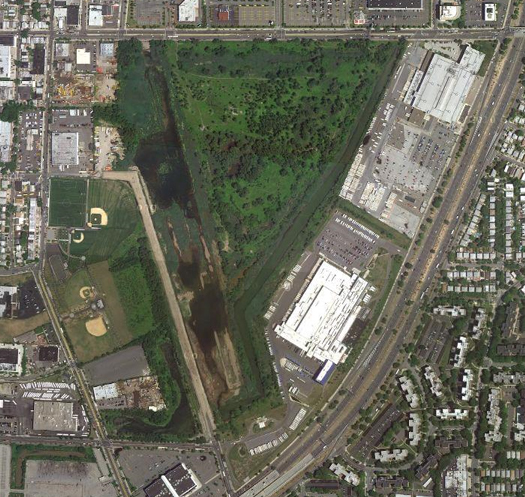
[Flushing Airport, one of New York City’s “places humans let be”, via Google Maps]
Robert Sullivan’s recent article on the renaissance of urban ecology in New York City, The Concrete Jungle, is so outstanding that I’ve been sitting on it for two weeks, paralyzed by the plethora of great quotes I could pull from it. In the end, I’ve narrowed down to three quotes, each of which emphasizes a different way in which our understandings of the composition, importance, and functions of urban natures are changing:
1. On the diversity of urban forests “Recently, however, scientists have come to suspect that urban forests have thrived not despite their urban environment but because of it. “The old idea was that urban areas are not ecologically interesting or don’t have ecological processes, and that’s false,” says Richard Pouyat, who studies urban forests for the U.S. Forest Service. “The difference is, it’s been altered.” And altering the natural landscape isn’t always a bad thing.
Take fires. Alley Pond experienced many car fires over the years, and this is now understood to have played an important role in the forest’s ecological health. In some parts of Alley Pond Park, as well as in forests in the Bronx and Staten Island, open forest canopies encouraged sensitive species like upland sandpipers or a threatened suite of plants like purple and green milkweeds. In a 1996 article in Restoration & Management Notes, Marc Matsil and Mike Feller, an early NRG naturalist, called arsonists “New York City’s incidental restorationists.”
Urban forests are healthier than their suburban peers in other ways, too. The flora scene is more diverse. Much of the soil found in places like Alley Pond Park is pristine compared to suburban areas. Perhaps more interesting, from the point of view of the larger urban ecosystem, our forests have evolved to become more productive. According to a study comparing oak-tree stands in rural Connecticut with ones in New York City, city forests carry more of the metals associated with air pollution into the soil.”
2. On the tension between process and aesthetics in ecological restoration “Understanding nature as infrastructure means thinking about it less as a painting to restore and more as a process to encourage. River-cleanup parties, those classic old-school conservation outings, may help in attracting humans to a restoration site, but they don’t necessarily do much for nature. “It’s fine if they realize that they are doing it for people and not for wildlife,” says Pehek, the NRG ecologist. “[But] roof material and plywood, for instance, is great for snakes.””
3. On future forests “In the city’s forests, Parks employees might take a more laissez-faire approach to invasive species. Some are targeted for removal, including the Norway maple, once the darling of Parks tree-planters throughout the East Coast but now known to release chemicals that discourage undergrowth. But mostly, urban foresters are comfortable with the idea that the species makeup of nature will change based on external events and that tomorrow’s forests won’t be the same as yesterday’s. They talk about encouraging the trajectory of the forest. The imminent arrival of the Emerald ash borer, an exotic beetle, may mean the destruction of thousands of ash trees in the next few years, but it also will bring about the beginning of something else.
This is a culture shift, and it has already happened in Europe, where biologists tracked plant and forest succession at bombed-out sites after the war. There, what Americans consider invasive species are tolerated as plants that thrive in the warmer, more acidic ecology of the city. “They just consider it nature, and this whole question of ‘natural or not natural’ is just a moot point,” says Peter Del Tredici, a senior scientist at the Harvard arboretum who teaches urban ecology at the Graduate School of Design.”
Read the full article for much more — from crypto-forestry and the previously mentioned future forests, to how Robert Moses became an accidental inspiration for urban restoration ecology, why urban ecologists are shifting from the documentation of remnant and accidental ecosystems to the active curation of new urban ecologies, or why it is important to think of urban nature and rural nature as components of a single system, intricately linked by webs of feedback loops.


[…] This post was mentioned on Twitter by Lindsey Mysse, Qb Gazette Feed. Qb Gazette Feed said: “it just makes things different”: [Flushing Airport, one of New York City's "places humans let be", via Google Ma… http://bit.ly/9NVExn […]
[…] Mammoth, of course. Related […]
One of the best New York magazine articles this year! A fourth theme might be perceptions of nature and here’s an exemplar excerpt:
“But part of the reason why it’s taken so long to discover New York’s nature is that this is not the nature we had been looking for. It’s less precious. It’s the opposite of pristine. In the city, we live in a nature that is even more resourceful and resilient than we have ever imagined. And when you look at nature that way, of course there are coyotes in New York. Look at all the forests and small mammals—not just rats, but also voles, chipmunks, and small red foxes—with whom we share the city. The question becomes: Where has the coyote been, and why are we so reluctant to have him? Why can’t we see the nature that we are living in? “
Yes! I could have done another three or four quotes easily, I think.
Wow! So glad you pointed me to this article. Great post.